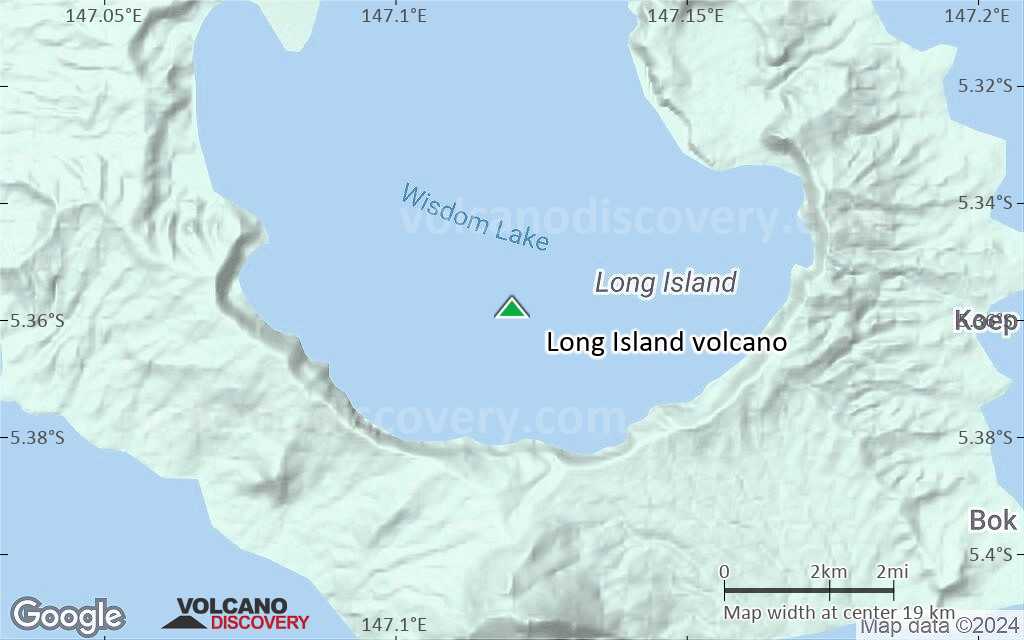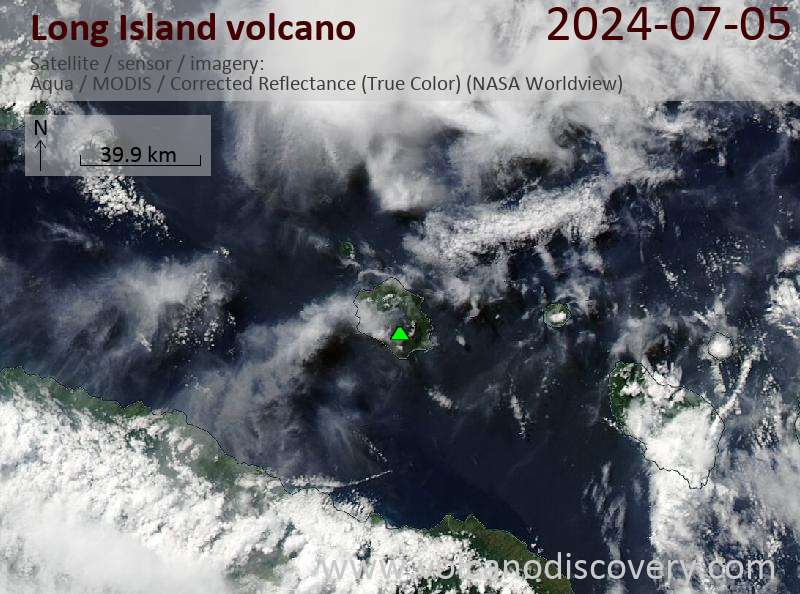Long Island Volcano
Long Island, located 136 km east of Madang in the Vitiaz Strait, consists of 2 adjacent partly collapsed steep-sided stratovolcanoes: Mount Reaumur in the north and Cerisy Peak in the south.
The central part of the complex contains a large 10x12.5 km caldera filled by a lake, Lake Wilson. The youngest eruptions have built a new cone inside the south-central part of the caldera lake, Motmot Island, which formed in 1953-54 and 1968. The historic eruptions in the 20th century occurred from vents at or near Motmot Island.
Long Island volcano's eruptions are often strombolian and sometimes submarine.
Long Island volcano eruptions: 1993, 1976, 1973-74, 1968, 1961(?), 1955, 1953-54, 1943, 1938, 1933, 1660
Latest nearby earthquakes
| Date and Time | Mag / Depth | Distance / Location | |||
|---|---|---|---|---|---|
Background
Collapse of the basaltic-andesitic volcanic complex produced a large 10 x 12.5 km caldera, now filled by Lake Wisdom. Caldera formation occurred during at least 3 major explosive eruptions, about 16,000, 4000, and 300 years ago. The latter was one of the largest historical eruptions in Papua New Guinea and deposited andesitic tephra across the New Guinea highlands, prompting legends of a "Time of Darkness."(Smithsonian / GVP volcano information)
Long Island Volcano Photos




Significant volcanic eruptions: Long Island volcano
There is one uncertain or discredited eruption in 1961 from Long Island volcano.
| Date | Note | VEI | Deaths | Damage | |
|---|---|---|---|---|---|
| E-W fissure NNE of Motmot Island Historical obs./docs. | 1 | ||||
| Motmot Historical obs./docs. | 1 | ||||
| Motmot Historical obs./docs. | 2 | ||||
| Motmot Historical obs./docs. | 2 | ||||
?? | Uncertain Eruption | ? | |||
| Motmot Historical obs./docs. | 3 | ||||
| Motmot Historical obs./docs. | 3 | ||||
| Motmot Historical obs./docs. | ? | ||||
| Lake Wisdom Historical obs./docs. | ? | ||||
| Lake Wisdom Historical obs./docs. | ? | ||||
| 1660 AD (eruption | Tsunami recorded Historical obs./docs. | 6 | 2,000 | heavy | Info |
| 6 | |||||
| -2040 BC (eruption | Historical obs./docs. | 6 | Info | ||
| 6 | |||||
Eruptions of Long Island volcano
A magnitude 5.1 earthquake hit 16 km SE of Long Island on 7 February 2010.
A magnitude 6.7 earthquake hit 54 km south of the volcano in November 2007.
New activity started at Long Island in early November 1993. At the surface, a change in the color of the crater lake from blue-green to orange-brown was observed. The eruption were likely underwater explosions in an area north of Motmot Island, near the center of Lake Wisdom. ...more info
Small ash eruptions occurred in April and May 1973 from a small island in the caldera lake.
Eruptions occurred at Long Island in March 1968 from vents the shore of the 1953-55 island (later Motmot Island), which by then had been eroded to a few rocks above the water. An ash cone formed in a few days and by November 1969 it had a crater with its own small pond. The island is now known as Motmot Island. ...more info
A new island, Motmot Island, appeared during submarine eruptions between May 1953 and January 1954. Surtseyan explosions (water-magma interaction) were observed 4 km from the south shore of Lake Wisdom in May 1953.
Motmot Island consisted of 2 craters joined by a ridge.
A large caldera-forming Plinian eruption took place at Long Island volcano in 1660. The volume of erupted magma was estimated to be as much as 30 cubic km of material, making ranking VEI=6 and as the 3rd largest known explosive eruption on earth during the past 2000 years. It was about 3 times larger than the 1883 eruption of Krakatau, and 10 times larger than the eruption of Mt St Helens in 1980.
Large amounts of ash were deposited on New Guinea and covered 87,000 km2 of the highlands with a layer of 1.5 cm. Long Island itself was buried beneath 30 m of ash fall and ash flow deposits.
Local legends in New Guinea talk of the "Time of Darkness", due to the giant eruption plume covering the sky, plunging the region under the ash plume into a darkness.
Long Island Volcano FAQ
+When was the last eruption of Long Island volcano?
The last confirmed eruption of Long Island occurred in 1993.
+How often does Long Island volcano erupt?
There are no known historic eruptions, but evidence from geologic records shows that it has had at least 11 eruptions over the past 10,000 years. This number is likely much higher because many past eruptions might not have left evidence recognizeable today and/or the volcano might not have been studied in too much detail. Using the available data, a very conservative estimate is that Long Island volcano erupts every 909 years.
+How active is Long Island volcano at present?
Long Island volcano is infrequently active: Since 1900, it has had 11 eruptions, and been active during 11 years out of 126 as of now. This means, Long Island has been in eruption one in 11.5 years on average. The last eruption was in 1993 and ended 32 years ago.
+When was the largest eruption of Long Island volcano?
The largest eruption known from the younger geological history of Long Island volcano occurred around 1660 AD. It ranks as a "vulcanian" eruption with a magnitude 3 on the VEI (Volcanic Explosivity Index) scale.
Latest satellite images
Long Island Volcano Maps





































